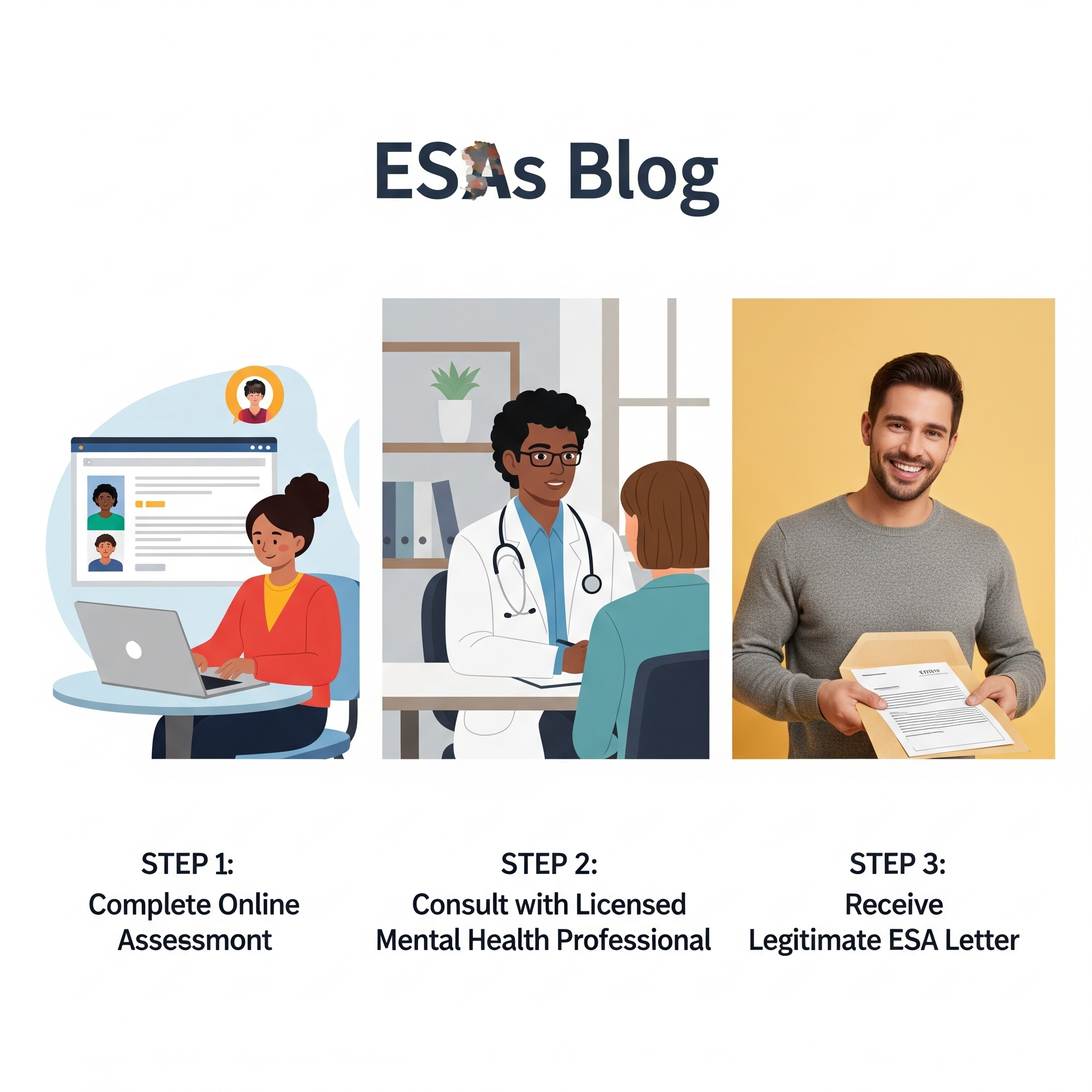Navigating Air Travel with Assistance Animals in a New Era
For many individuals living with mental health conditions, Emotional Support Animals (ESAs) provide a lifeline of comfort, stability, and emotional regulation. Historically, federal regulations, particularly the Air Carrier Access Act (ACAA), afforded ESAs certain accommodations on commercial flights, allowing them to travel in the cabin with their handlers free of charge. However, significant changes implemented by the U.S. Department of Transportation (DOT) have fundamentally reshaped the landscape of air travel with ESAs.
At CertifyESA, we believe in empowering our clients with accurate, up-to-date information to ensure they understand their rights and responsibilities. The DOT’s Final Rule, which became effective in early 2021, represents a pivotal shift that every individual considering flying with an assistance animal needs to comprehend. This blog will delve into the specifics of this rule, explain its rationale, and clarify the key differences between ESAs and Psychiatric Service Dogs (PSDs) in the context of air travel.
The Evolution of Air Travel Regulations for Assistance Animals
Before the DOT’s Final Rule, the Air Carrier Access Act (ACAA) broadly defined “service animal” to include animals that provide emotional support. This meant that emotional support animals, with a legitimate letter from a licensed mental health professional, were generally permitted to fly in the cabin with their handlers without a fee.
However, over time, several concerns emerged:
-
Misbehavior and Safety Incidents: Reports of unruly or untrained animals causing disruptions, biting passengers, or creating sanitation issues on flights increased (U.S. Department of Transportation, 2020a).
-
Fraudulent Representation: A rise in individuals misrepresenting their pets as ESAs to avoid pet fees or bypass breed restrictions led to a decline in public trust and made it difficult for airlines to distinguish between legitimate assistance animals and untrained pets (U.S. Department of Transportation, 2020a).
-
Unusual Species: The broad definition sometimes led to requests to bring unusual and potentially disruptive animals, such as miniature horses, pigs, or even peacocks, into the cabin (U.S. Department of Transportation, 2020a).
In response to these growing concerns and stakeholder feedback, the DOT undertook a comprehensive rulemaking process. The goal was to balance the needs of individuals with disabilities with the safety and comfort of all air travelers.
The DOT’s Final Rule: Key Changes Explained
On December 2, 2020, the U.S. Department of Transportation announced its “Traveling by Air with Service Animals” final rule, which became effective on January 11, 2021. This rule fundamentally alters the definition of a “service animal” under the Air Carrier Access Act, bringing it into closer alignment with the Americans with Disabilities Act (ADA) definition.
Here are the most significant changes:
-
Redefinition of “Service Animal”: The rule explicitly defines a “service animal” as “a dog, regardless of breed or type, that is individually trained to do work or perform tasks for the benefit of a qualified individual with a disability, including a physical, sensory, psychiatric, intellectual, or other mental disability” (U.S. Department of Transportation, 2020b).
-
Exclusion of Emotional Support Animals: Crucially, the final rule states that airlines are no longer required to recognize emotional support animals as service animals. This means that ESAs are now generally treated as pets by airlines and are subject to the airline’s standard pet policies, which typically include fees, carrier requirements, and breed/size restrictions (U.S. Department of Transportation, 2020b).
-
Inclusion of Psychiatric Service Dogs (PSDs): While ESAs are no longer recognized, the rule affirms that Psychiatric Service Dogs (PSDs) are indeed service animals and must be accommodated. PSDs, like other service animals, are individually trained to perform specific tasks to mitigate a psychiatric disability (U.S. Department of Transportation, 2020b). Examples of such tasks include interrupting self-harm, providing deep pressure therapy during anxiety attacks, or reminding a handler to take medication.
-
Documentation Requirements for Service Animals (including PSDs): Airlines are now permitted to require passengers traveling with service animals (including PSDs) to provide two specific forms developed by the DOT:
- U.S. Department of Transportation Service Animal Air Transportation Form: This form attests to the animal’s health, behavior, and training.
- U.S. Department of Transportation Service Animal Relief Attestation Form: For flights eight hours or longer, this form attests that the animal can either not relieve itself or can do so in a sanitary manner.
- Airlines can require these forms up to 48 hours in advance of travel if the reservation was made prior to that time, or at the departure gate on the day of travel (U.S. Department of Transportation, 2020b).
-
No Mandatory LMHP Letter for PSDs (for air travel): Unlike the previous rules for ESAs, airlines are no longer permitted to require a letter from a licensed mental health professional as a condition for transporting a Psychiatric Service Dog (U.S. Department of Transportation, 2020b). The focus is now on the dog’s training to perform disability-mitigating tasks.
-
Limit on Number of Service Animals: Airlines can limit the number of service animals traveling with a single passenger to two (U.S. Department of Transportation, 2020b).
-
Seating and Restraint: Service animals must fit within their handler’s foot space on the aircraft. They must also be harnessed, leashed, or tethered at all times in the airport and on the aircraft, unless the restraint interferes with the animal’s ability to perform its tasks or the handler’s disability prevents its use (U.S. Department of Transportation, 2020b).
-
Refusal of Transportation: Airlines can still refuse transportation to service animals that exhibit aggressive behavior or pose a direct threat to the health or safety of others. However, they cannot refuse transport solely based on breed (U.S. Department of Transportation, 2020b).
The Impact on ESA Owners: What Now?
The DOT’s Final Rule has had a significant impact on individuals who previously relied on ESA letters for air travel.
-
Flying with an ESA is Now Like Flying with a Pet: If you wish to travel with your Emotional Support Animal on an airline, you will likely need to comply with the airline’s standard pet policies. This often means:
- Pet Fees: Expect to pay a fee for your animal.
- Carrier Requirements: Your ESA may need to travel in a carrier that fits under the seat in front of you.
- Breed/Size Restrictions: Airlines may have restrictions on the breed or size of animals allowed in the cabin or cargo.
- Cargo Travel: Larger ESAs that cannot fit in the cabin may need to travel in the cargo hold, which carries its own risks and regulations.
-
No Special Accommodations in Air Travel: The special accommodations that ESAs once received on flights (free travel in the cabin) are no longer mandated by federal law.
The Continued Importance of ESAs and PSDs (Outside of Air Travel)
It’s crucial to understand that the DOT’s Final Rule only applies to air travel. It does not affect protections for ESAs and PSDs under other federal laws:
-
Fair Housing Act (FHA): ESAs continue to be recognized as “assistance animals” under the FHA. Landlords are still required to provide reasonable accommodations for individuals with disabilities to live with their ESAs in “no-pet” housing, without charging pet fees or deposits, provided they have a legitimate ESA letter from a licensed mental health professional (U.S. Department of Housing and Urban Development, 2020).
-
Americans with Disabilities Act (ADA): The ADA protects Psychiatric Service Dogs (PSDs) by granting them access to public places where pets are generally not allowed. This includes stores, restaurants, and other public accommodations. The ADA explicitly states that service animals are dogs trained to perform tasks for a person with a disability, and it does not recognize ESAs as service animals for public access purposes (U.S. Department of Justice, 2020).
Therefore, while air travel has changed, the value and legal recognition of ESAs and PSDs for housing and public access (for PSDs) remain strong.
CertifyESA: Your Partner in Understanding and Accessing Legitimate Support
At CertifyESA, we recognize the confusion and concern that the DOT’s Final Rule may have caused for many individuals. Our commitment is to provide clarity and facilitate access to legitimate assistance animal documentation for both housing and, where applicable, for understanding the requirements for PSDs in air travel.
-
Expert Guidance on the Rule: We ensure our clients are fully informed about the current DOT regulations, helping them understand what accommodations they can expect when flying with an ESA (as a pet) or a PSD.
-
Legitimate ESA Letters for Housing: Our primary focus remains on connecting individuals with licensed mental health professionals who can provide legitimate ESA letters compliant with the Fair Housing Act. These letters are essential for securing housing accommodations.
-
Assessment for Psychiatric Service Dogs: For those who believe they may qualify for a Psychiatric Service Dog, our network of licensed mental health professionals can assess their condition and, if appropriate, discuss the criteria and process for having a PSD. While the DOT no longer requires a letter from an LMHP for a PSD in air travel, a comprehensive mental health assessment is still crucial to ensure the animal truly mitigates a disability and to understand the responsibilities of a PSD handler.
-
Focus on Ethical Practice: We advocate for ethical practices in the assistance animal community, which includes discouraging the misrepresentation of pets as service animals. This approach helps to protect the integrity of legitimate assistance animal programs for those who truly need them.
Planning Your Travel: Tips for ESA and PSD Owners
Given the changes, responsible planning is key for any individual traveling with an assistance animal:
-
For ESAs:
- Contact Your Airline: Always contact your specific airline well in advance of your travel date to inquire about their current pet policies, fees, carrier requirements, and any breed or size restrictions.
- Prepare Your Pet: Ensure your ESA is comfortable in a carrier (if required) and accustomed to travel.
-
For Psychiatric Service Dogs:
- Understand DOT Forms: Be prepared to complete and submit the required U.S. DOT Service Animal Air Transportation Form and, for long flights, the U.S. DOT Service Animal Relief Attestation Form.
- Ensure Task Training: Remember that your PSD must be individually trained to perform specific tasks related to your psychiatric disability. Be prepared to explain what task(s) your dog performs.
- Behavior and Control: Your PSD must be well-behaved and under your control at all times. Disruptive behavior can lead to denial of boarding.
- Fit in Foot Space: Your PSD must be able to fit in your foot space without encroaching on other passengers’ space or blocking aisles.
Conclusion: Adapting to the New Reality
The DOT’s Final Rule on Emotional Support Animals and air travel represents a significant change, clarifying the distinction between ESAs and service animals for the purposes of air travel. While ESAs no longer receive special accommodations on flights, their vital role in providing comfort and support for mental health in housing settings remains legally protected. Psychiatric Service Dogs, as trained service animals, continue to have accommodations for air travel, albeit with new documentation requirements.
At CertifyESA, we are committed to helping you understand these nuanced regulations and secure the legitimate documentation you need. Whether you are seeking an ESA letter for housing or understanding the requirements for flying with a Psychiatric Service Dog, our connection to licensed mental health professionals ensures you receive accurate information and ethical, legally compliant support. Your well-being is our priority, and navigating the complexities of assistance animal laws is a crucial part of that commitment.
APA Formatted Citations:
U.S. Department of Housing and Urban Development. (2020, January 28). Assessing a person’s request to have an animal as a reasonable accommodation under the Fair Housing Act. Retrieved from https://www.hud.gov/sites/dfiles/FHEO/documents/HUD_Guidance_on_ESA_01-28-2020.pdf
U.S. Department of Justice. (2020, July 1). Service animals. ADA.gov. Retrieved from https://www.ada.gov/resources/service-animals-2010-regulations/
U.S. Department of Transportation. (2020a, December 2). U.S. Department of Transportation announces final rule on traveling by air with service animals. Retrieved from https://www.transportation.gov/briefing-room/us-department-transportation-announces-final-rule-traveling-air-service-animals
U.S. Department of Transportation. (2020b, December 2). Traveling by Air with Service Animals; Final Rule. Federal Register. Retrieved from https://www.transportation.gov/sites/dot.gov/files/2020-12/Service%20Animal%20Final%20Rule.pdf





